An Adaptive Subinterval Finite Element Method Based on Dynamic Sensitivity Analysis for Structures with Uncertain-but-Bounded Parameters
Abstract
:1. Introduction
2. Problem Statement
2.1. Interval Mathematics
2.2. Interval Finite Element Equation
3. Adaptive Subinterval Finite Element Method Based on Dynamic Sensitivity Analysis
3.1. Improved Interval Finite Element Method
3.2. Existing Subinterval Finite Element Method
3.3. Dynamic-Sensitivity-Based Subinterval Finite Element Analysis Method
3.4. An Adaptive Convergence Mechanism and Computational Procedure
- (1)
- Set and .
- (2)
- Solve the upper and lower bounds of the displacement in the original interval, noted as and .
- (3)
- Set and , and then, divide each interval into m subintervals.
- (4)
- Find the upper bound and lower bound using the subinterval finite element method based on dynamic sensitivity analysis and assemble them as and .
- (5)
- Calculate the iteration error .
- (6)
- If is not larger than the permissible error , output and as the upper and lower bounds of the structural displacement response. Otherwise, return to the third step.
4. Applications
4.1. Nine-Bar Truss
- (1)
- As can be seen from Table 4, the calculation time for the PM is much less than that of VM, despite the fact that the permissible error for the PM is as small as 1‰. For VM, the equilibrium equation needs to be solved for all the possible combinations of intervals. Thus, the computational cost is exponentially related to the number of interval parameters. Such large computational costs are unacceptable, especially for structures containing many interval parameters. However, for the PM, the computational cost is much less than that of VM because the equilibrium equations only need to be solved at specific points. Therefore, the PM can be applied to interval finite element analysis with a large number of uncertain parameters and retains sufficient computational efficiency.
- (2)
- As expected, the errors for these interval analysis methods in Figure 7 all increase as the level of uncertainty rises. However, the calculations show that the displacement response bounds solved by the PM are more accurate than the other two methods. When the uncertainty level reaches 30%, the maximum errors for SDAM and STM reach 42.43% and 36.31%, respectively, while the maximum error for the PM is only 0.28%. Therefore, the PM is suitable for analyzing the displacement response of structures under high levels of uncertainty.
- (3)
- For all three cases, the iteration error gradually decreases. Until the iteration error decreases below the permissible error , suitable computational results are obtained. Case 1 and case 2 require only five and six iterations, respectively, whereas case 3 requires seven iterations. This suggests that the number of iterations of the PM gradually increases as the uncertainty of the structure rises.
4.2. Impeller
- (1)
- The response bounds obtained for SDAM, STM, and the PM have a tendency to increase with the level of uncertainty rising. When the uncertainty level reaches 30%, the maximum errors for SDAM are −119.06% and those for STM are −127.33%. However, the error of the results obtained using the PM does not exceed 1%. Although the PM only retains the first-order term of the Taylor expansion, its accuracy is higher than STM, which retains the second-order term. There are two main reasons for this: Firstly, the PM utilizes a modified Neumann series, which retains higher-order terms of the Neumann series. Secondly, the PM divides the interval into subintervals, reducing the uncertainty level during the solving process. The reason why the PM is more accurate than SDAM is that SDAM only expands at the midpoint of the interval to approximate the response at the combination point, while the PM solves within the subinterval domains of each expansion route.
- (2)
- PM is still suitable for finite element models with high levels of uncertainty and multiple parameters and can maintain good efficiency. The computational effort of SM increases exponentially with the number of parameters, which makes it limited when the number of interval parameters is large. However, the cost of computation is significantly reduced when using PM because it only needs to solve the equilibrium equations along the expansion routes.
- (3)
- According to Figure 9, increasing the uncertainty of interval parameters leads to the expansion of the response interval. This indicates that the extreme conditions of the structure can only be predicted when uncertainty is taken into account. Design solutions obtained by considering uncertainty are more secure and reliable.
5. Conclusions
Author Contributions
Funding
Institutional Review Board Statement
Informed Consent Statement
Data Availability Statement
Acknowledgments
Conflicts of Interest
References
- Fu, Z.; Tian, L.; Liu, J. Seismic response and collapse analysis of a transmission tower-line system considering uncertainty factors. J. Constr. Steel Res. 2022, 189, 107094. [Google Scholar] [CrossRef]
- Fu, C.; Sinou, J.J.; Zhu, W.; Lu, K.; Yang, Y. A state-of-the-art review on uncertainty analysis of rotor systems. Mech. Syst. Signal Process. 2023, 183, 109619. [Google Scholar] [CrossRef]
- Tang, Z.; Li, W.; Zhou, S.; Sun, J. Research on Railway Emergency Resources Scheduling Model under Multiple Uncertainties. Appl. Sci. 2023, 13, 4432. [Google Scholar] [CrossRef]
- Zhou, X.; Sun, Y.; Xiao, H. Simulation of Cross-Correlated Random Fields for Transversely Anisotropic Soil Slope by Copulas. Appl. Sci. 2023, 13, 4234. [Google Scholar] [CrossRef]
- Yang, Z.; Huang, J.; Yang, D.; Zhong, Z. Design and optimization of robust path tracking control for autonomous vehicles with fuzzy uncertainty. IEEE Trans. Fuzzy Syst. 2021, 30, 1788–1800. [Google Scholar] [CrossRef]
- Łasecka Plura, M. Dynamic Characteristics of a Composite Beam with Viscoelastic Layers under Uncertain-but-Bounded Design Parameters. Appl. Sci. 2023, 13, 6473. [Google Scholar] [CrossRef]
- Ma, J.; Fu, C.; Zheng, Z.; Lu, K.; Yang, Y. The Effects of Interval Uncertainties on Dynamic Characteristics of a Rotor System Supported by Oil-Film Bearings. Lubricants 2022, 10, 354. [Google Scholar] [CrossRef]
- Moore, R.E. Interval Analysis; Prentice-Hall: Englewood Cliffs, NJ, USA, 1966; Volume 4. [Google Scholar]
- Alefeld, G.; Herzberger, J. Introduction to Interval Computation; Academic Press: Cambridge, MA, USA, 2012. [Google Scholar]
- Long, X.; Jiang, C.; Han, X.; Tang, J.; Guan, F. An enhanced subinterval analysis method for uncertain structural problems. Appl. Math. Model. 2018, 54, 580–593. [Google Scholar] [CrossRef]
- Muhanna, R.L.; Zhang, H.; Mullen, R.L. Interval finite elements as a basis for generalized models of uncertainty in engineering mechanics. Reliab. Comput. 2007, 13, 173–194. [Google Scholar] [CrossRef]
- Chen, S.H.; Yang, X.W. Interval finite element method for beam structures. Finite Elem. Anal. Des. 2000, 34, 75–88. [Google Scholar] [CrossRef]
- Fu, C.; Zheng, Z.; Zhu, W.; Lu, K.; Yang, Y. Non-intrusive frequency response analysis of nonlinear systems with interval uncertainty: A comparative study. Chaos Solitons Fractals 2022, 165, 112815. [Google Scholar] [CrossRef]
- Fu, C.; Cao, L.; Tang, J.; Long, X. A subinterval decomposition analysis method for uncertain structures with large uncertainty parameters. Comput. Struct. 2018, 197, 58–69. [Google Scholar] [CrossRef]
- Rao, S.S.; Berke, L. Analysis of uncertain structural systems using interval analysis. AIAA J. 1997, 35, 727–735. [Google Scholar] [CrossRef]
- Wu, J.; Zhang, Y.; Chen, L.; Luo, Z. A Chebyshev interval method for nonlinear dynamic systems under uncertainty. Appl. Math. Model. 2013, 37, 4578–4591. [Google Scholar] [CrossRef]
- Fu, C.; Yang, Y.; Lu, K.; Gu, F. Nonlinear vibration analysis of a rotor system with parallel and angular misalignments under uncertainty via a Legendre collocation approach. Int. J. Mech. Mater. Des. 2020, 16, 557–568. [Google Scholar] [CrossRef]
- Zheng, Y.; Qiu, Z. Uncertainty propagation in aerodynamic forces and heating analysis for hypersonic vehicles with uncertain-but-bounded geometric parameters. Aerosp. Sci. Technol. 2018, 77, 11–24. [Google Scholar] [CrossRef]
- Liu, Y.; Wang, X.; Wang, L.; Lv, Z. A Bayesian collocation method for static analysis of structures with unknown-but-bounded uncertainties. Comput. Methods Appl. Mech. Eng. 2019, 346, 727–745. [Google Scholar] [CrossRef]
- De, S.; Maute, K.; Doostan, A. Bi-fidelity stochastic gradient descent for structural optimization under uncertainty. Comput. Mech. 2020, 66, 745–771. [Google Scholar] [CrossRef]
- Qiu, Z.; Zhu, B. A Newton iteration-based interval analysis method for nonlinear structural systems with uncertain-but-bounded parameters. Int. J. Numer. Methods Eng. 2021, 122, 4922–4943. [Google Scholar] [CrossRef]
- Dinh-Cong, D.; Van Hoa, N.; Nguyen-Thoi, T. An effective optimization-based parameterized interval analysis approach for static structural response with multiple uncertain parameters. Eng. Comput. 2020, 36, 1889–1902. [Google Scholar] [CrossRef]
- Kabir, H.D.; Khosravi, A.; Hosen, M.A.; Nahavandi, S. Neural network-based uncertainty quantification: A survey of methodologies and applications. IEEE Access 2018, 6, 36218–36234. [Google Scholar] [CrossRef]
- Wang, L.; Liu, Y.; Gu, K.; Wu, T. A radial basis function artificial neural network (RBF ANN) based method for uncertain distributed force reconstruction considering signal noises and material dispersion. Comput. Methods Appl. Mech. Eng. 2020, 364, 112954. [Google Scholar] [CrossRef]
- Abdullah, A.A.; Hassan, M.M.; Mustafa, Y.T. Uncertainty Quantification for MLP-Mixer Using Bayesian Deep Learning. Appl. Sci. 2023, 13, 4547. [Google Scholar] [CrossRef]
- Qiu, Z.; Chen, S.; Elishakoff, I. Bounds of eigenvalues for structures with an interval description of uncertain-but-non-random parameters. Chaos Solitons Fractals 1996, 7, 425–434. [Google Scholar] [CrossRef]
- Xia, B.; Yu, D. Interval analysis of acoustic field with uncertain-but-bounded parameters. Comput. Struct. 2012, 112, 235–244. [Google Scholar] [CrossRef]
- Wu, F.; Gong, M.; Ji, J.; Peng, G.; Yao, L.; Li, Y.; Zeng, W. Interval and subinterval perturbation finite element-boundary element method for low-frequency uncertain analysis of structural-acoustic systems. J. Sound Vib. 2019, 462, 114939. [Google Scholar] [CrossRef]
- Wang, C.; Qiu, Z. Modified perturbation method for eigenvalues of structure with interval parameters. Sci. China Physics, Mech. Astron. 2015, 58, 1–9. [Google Scholar] [CrossRef]
- Moore, R.E.; Kearfott, R.B.; Cloud, M.J. Introduction to Interval Analysis; SIAM: Philadelphia, PA, USA, 2009. [Google Scholar]
- Degrauwe, D.; Lombaert, G.; De Roeck, G. Improving interval analysis in finite element calculations by means of affine arithmetic. Comput. Struct. 2010, 88, 247–254. [Google Scholar] [CrossRef]
- Sofi, A.; Romeo, E. A novel interval finite element method based on the improved interval analysis. Comput. Methods Appl. Mech. Eng. 2016, 311, 671–697. [Google Scholar] [CrossRef]
- Sofi, A.; Romeo, E.; Barrera, O.; Cocks, A. An interval finite element method for the analysis of structures with spatially varying uncertainties. Adv. Eng. Softw. 2019, 128, 1–19. [Google Scholar] [CrossRef]
- Chen, S.H.; Ma, L.; Meng, G.W.; Guo, R. An efficient method for evaluating the natural frequencies of structures with uncertain-but-bounded parameters. Comput. Struct. 2009, 87, 582–590. [Google Scholar] [CrossRef]
- Xia, B.; Yu, D. Modified interval and subinterval perturbation methods for the static response analysis of structures with interval parameters. J. Struct. Eng. 2014, 140, 04013113. [Google Scholar] [CrossRef]
- Horn, R.A. The hadamard product. Proc. Symp. Appl. Math 1990, 40, 87–169. [Google Scholar]
- Wu, M.; Yin, B.; Vosoughi, A.; Studer, C.; Cavallaro, J.R.; Dick, C. Approximate matrix inversion for high-throughput data detection in the large-scale MIMO uplink. In Proceedings of the 2013 IEEE International Symposium on Circuits and Systems (ISCAS), Beijing, China, 19–23 May 2013; pp. 2155–2158. [Google Scholar]
- Chen, S.; Lian, H.; Yang, X. Interval static displacement analysis for structures with interval parameters. Int. J. Numer. Methods Eng. 2002, 53, 393–407. [Google Scholar] [CrossRef]
- Wu, F.; Gong, M.; Yao, L.; Hu, M.; Jie, J. High precision interval analysis of the frequency response of structural-acoustic systems with uncertain-but-bounded parameters. Eng. Anal. Bound. Elem. 2020, 119, 190–202. [Google Scholar] [CrossRef]
- Zhou, Y.; Jiang, C.; Han, X. Interval and subinterval analysis methods of the structural analysis and their error estimations. Int. J. Comput. Methods 2006, 3, 229–244. [Google Scholar] [CrossRef]
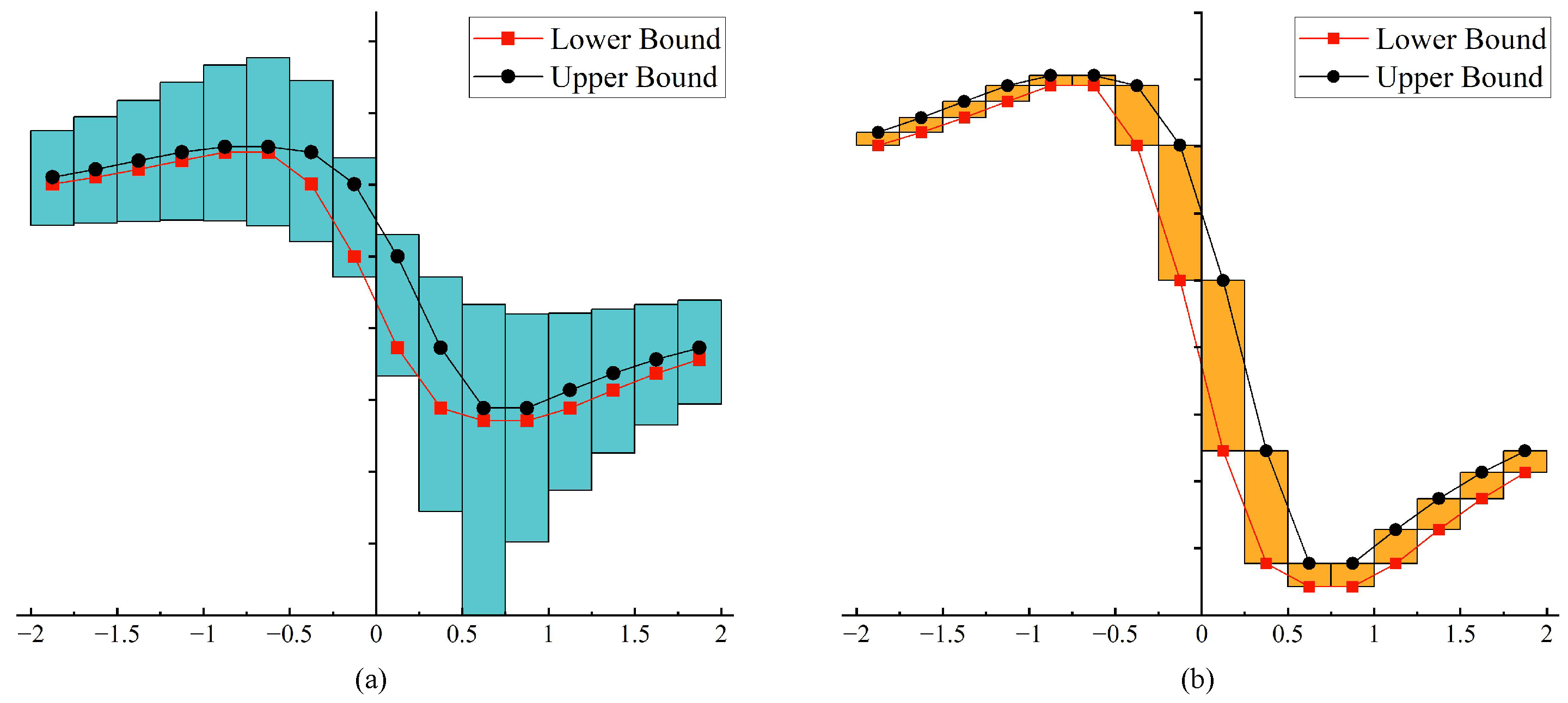
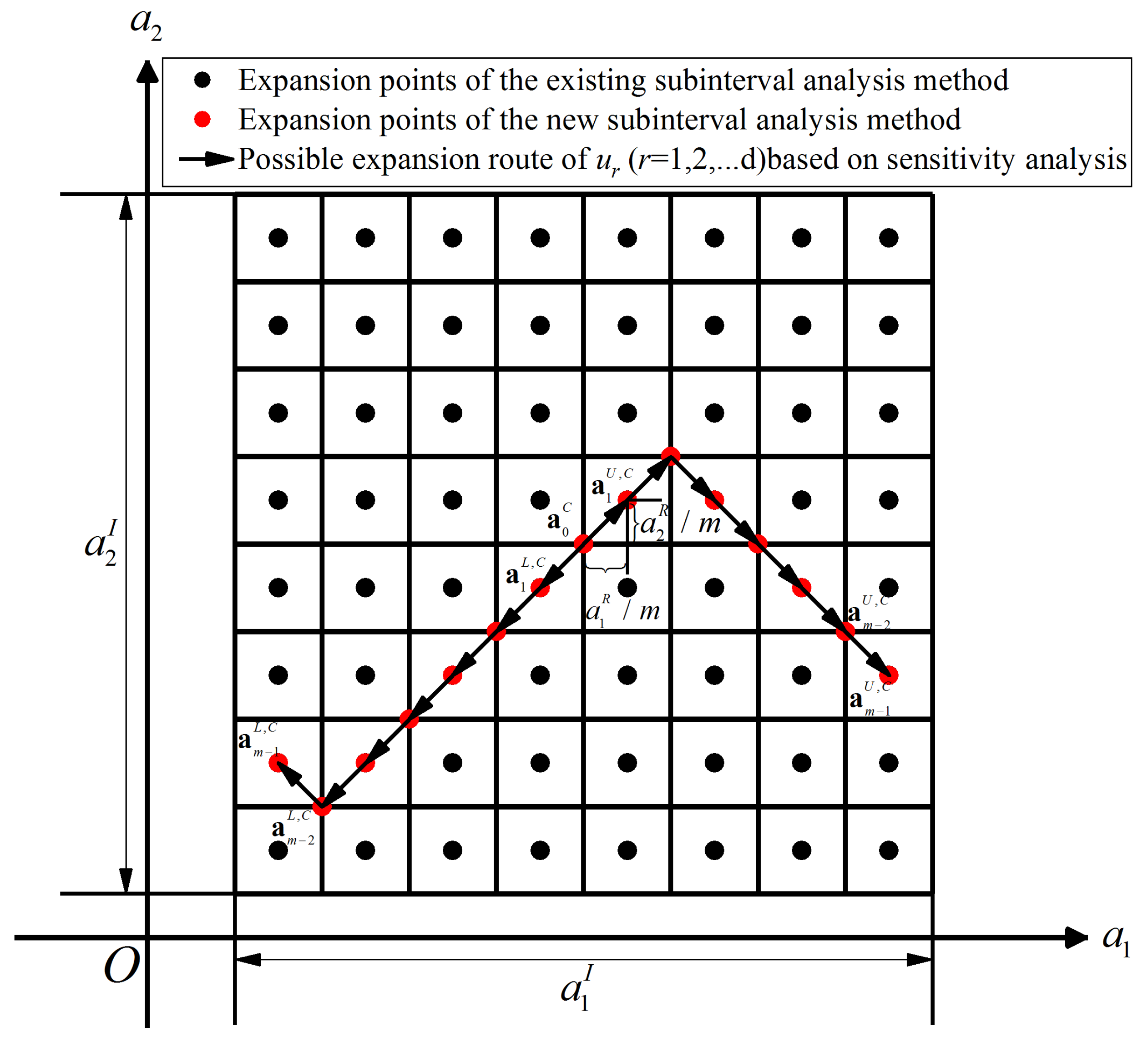
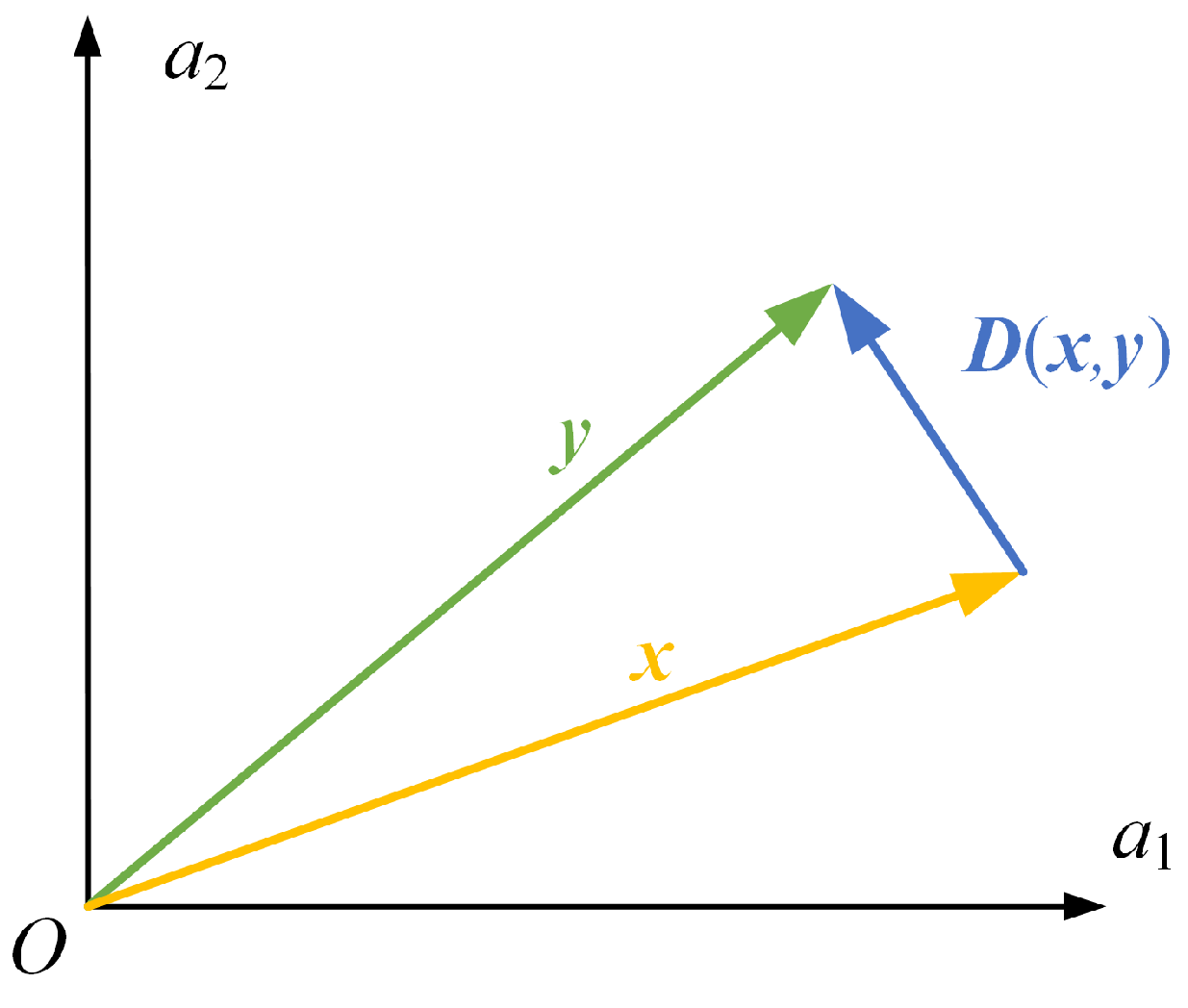
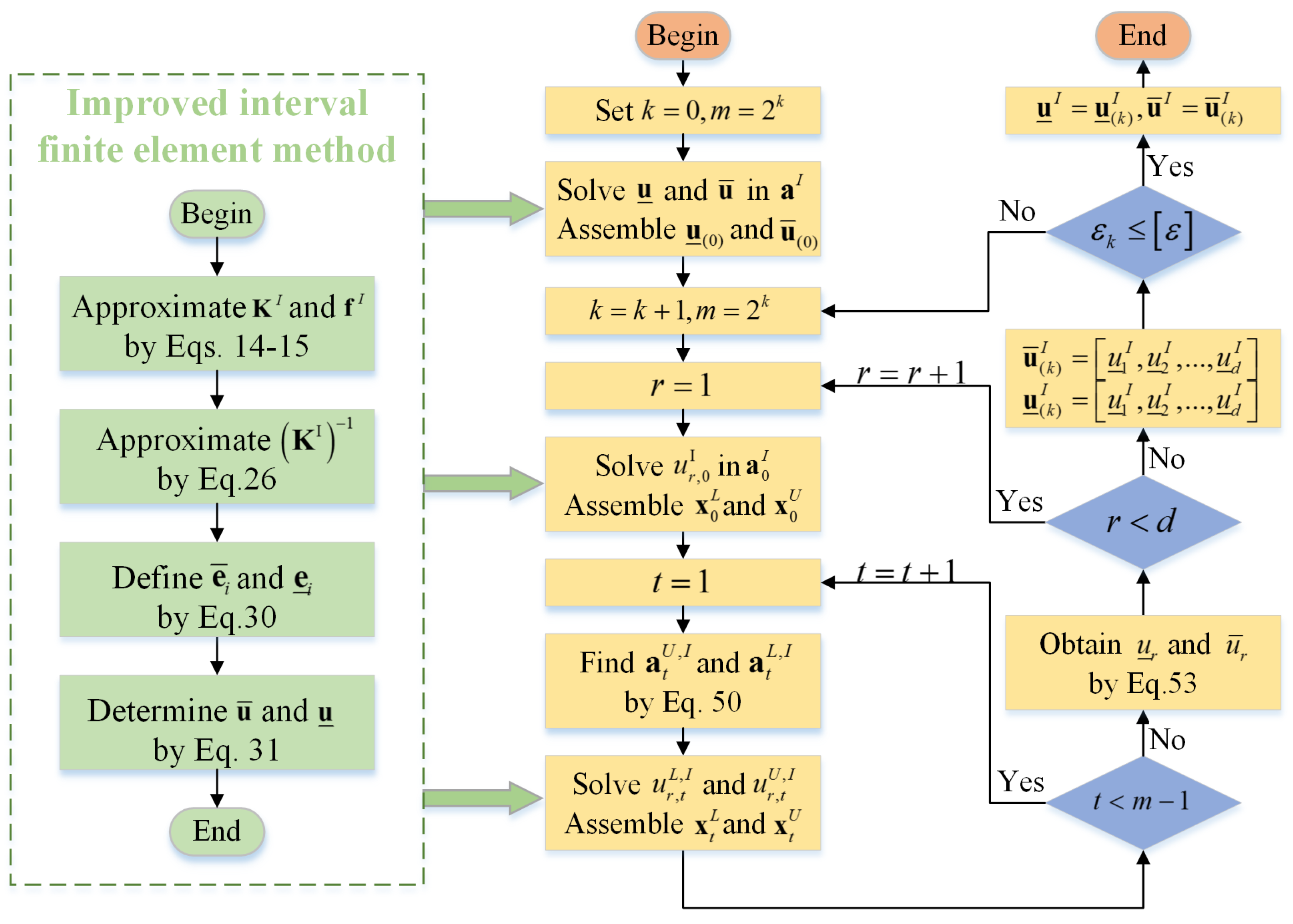

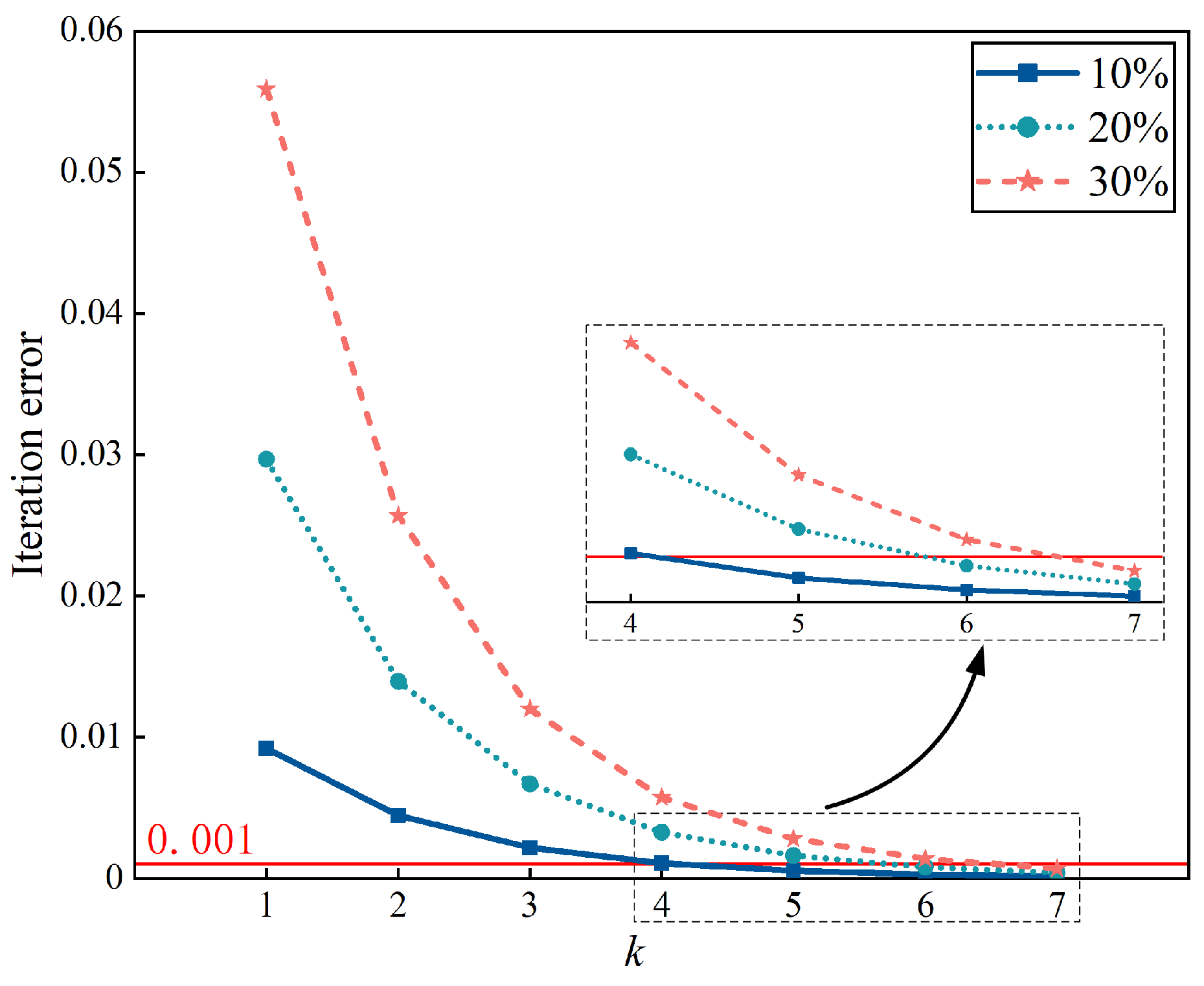


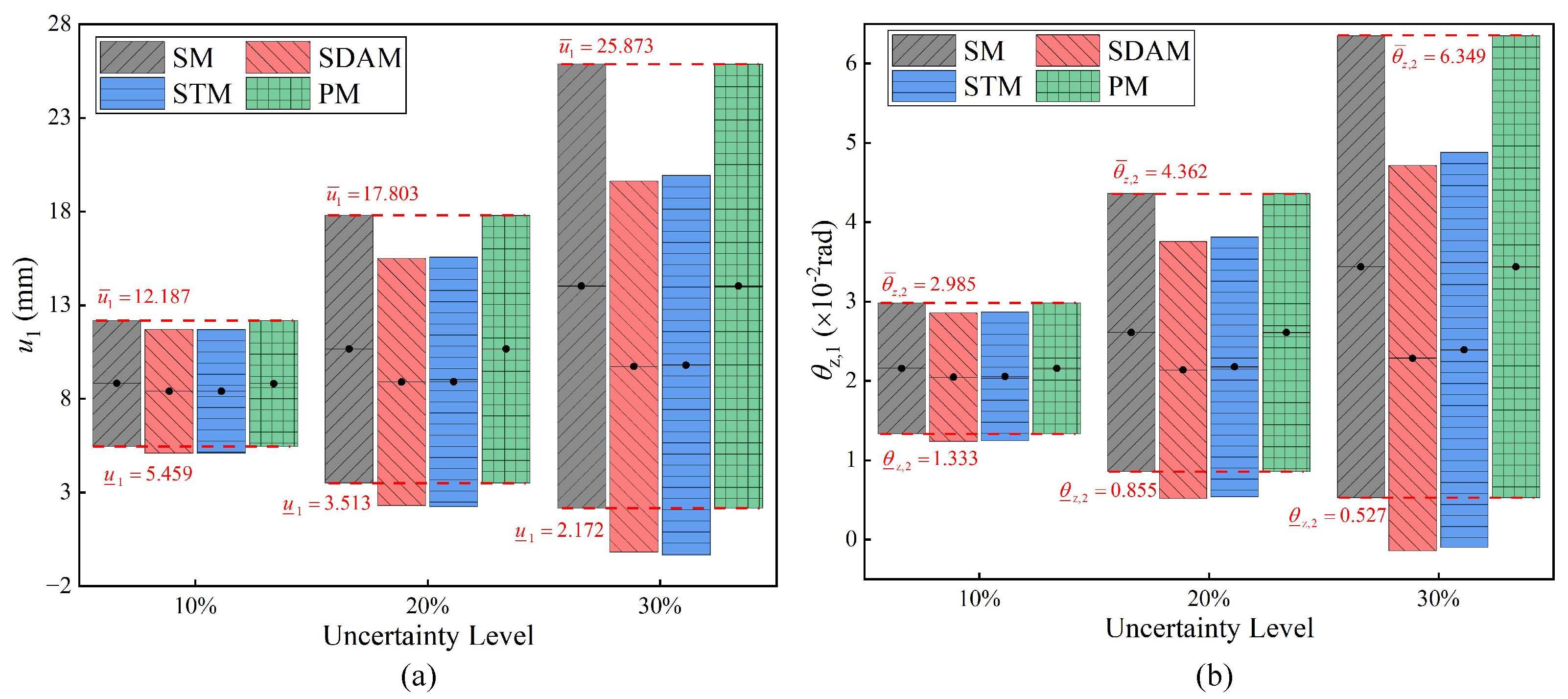

| Uncertainty Levels | Case1 | Case2 | Case3 |
|---|---|---|---|
| 10% | 20% | 30% |
| Uncertainty Level | Bounds | SM | STM | SDAM | PM ( = 1‰) | |||
|---|---|---|---|---|---|---|---|---|
| Value (mm) | Value (mm) | Error | Value (mm) | Error | Value (mm) | Error | ||
| 10% | LB | −0.453 | −0.404 | 10.91% | −0.408 | 20.00% | −0.452 | 0.28% |
| UB | 0.453 | 0.404 | −10.91% | 0.408 | −20.00% | 0.453 | 0.00% | |
| 20% | LB | −1.052 | −0.808 | 23.21% | −0.842 | 20.00% | −1.049 | 0.26% |
| UB | 1.052 | 0.808 | −23.21% | 0.842 | −20.00% | 1.052 | 0.00% | |
| 30% | LB | −1.903 | −1.212 | 36.31% | −1.332 | 30.00% | −1.900 | 0.18% |
| UB | 1.903 | 1.212 | −36.31% | 1.332 | −30.00% | 1.903 | 0.00% | |
| Uncertainty Level | Bounds | SM | STM | SDAM | PM ( = 1‰) | |||
|---|---|---|---|---|---|---|---|---|
| Value (mm) | Value (mm) | Error | Value (mm) | Error | Value (mm) | Error | ||
| 10% | LB | −2.744 | −2.667 | 2.80% | −2.671 | 2.64% | −2.744 | 0.00% |
| UB | −1.503 | −1.455 | 3.20% | −1.451 | 3.44% | −1.503 | 0.00% | |
| 20% | LB | −3.788 | −3.394 | 10.40% | −3.435 | 9.33% | −3.788 | 0.00% |
| UB | −1.122 | −0.970 | 13.60% | −0.943 | 16.00% | −1.122 | 0.00% | |
| 30% | LB | −5.360 | −4.202 | 21.60% | −4.358 | 18.69% | −5.360 | 0.00% |
| UB | −0.837 | −0.566 | 32.40% | −0.482 | 42.43% | −0.837 | 0.00% | |
| Methods | VM | SDAM | STM | PM | ||
|---|---|---|---|---|---|---|
| = 1% | = 5‰ | = 1‰ | ||||
| Calculation time(s) | 72.805 | 0.038 | 0.020 | 0.154 | 0.513 | 5.547 |
| Parameters | Density | Young’s Modulus | Thickness | Angular Velocity |
|---|---|---|---|---|
| Interval median |
| Uncertainty Level | Bounds | SM | STM | SDAM | PM ( = 1‰) | |||
|---|---|---|---|---|---|---|---|---|
| Value (mm) | Value (mm) | Error | Value (mm) | Error | Value (mm) | Error | ||
| 10% | LB | 5.459 | 5.106 | −6.47% | 5.098 | −6.60% | 5.454 | −0.09% |
| UB | 12.187 | 11.701 | −3.99% | 11.710 | −3.91% | 12.182 | −0.04% | |
| 20% | LB | 3.513 | 2.301 | −34.50% | 2.247 | −36.04% | 3.508 | −0.14% |
| UB | 17.803 | 15.492 | −12.98% | 15.575 | −12.52% | 17.798 | −0.03% | |
| 30% | LB | 2.172 | −0.174 | −108.02% | −0.343 | −115.82% | 2.169 | −0.12% |
| UB | 25.873 | 19.613 | −24.20% | 19.931 | −22.97% | 25.869 | −0.02% | |
| Uncertainty Level | Bounds | SM | STM | SDAM | PM ( = 1‰) | |||
|---|---|---|---|---|---|---|---|---|
| Value ( Rad) | Value ( Rad) | Error | Value ( Rad) | Error | Value ( Rad) | Error | ||
| 10% | LB | 1.333 | 1.236 | −7.28% | 1.243 | −6.72% | 1.332 | −0.09% |
| UB | 2.985 | 2.856 | −4.33% | 2.867 | −3.94% | 2.984 | −0.04% | |
| 20% | LB | 0.855 | 0.516 | −39.69% | 0.540 | −36.86% | 0.854 | −0.14% |
| UB | 4.362 | 3.756 | −13.91% | 3.814 | −12.58% | 4.361 | −0.03% | |
| 30% | LB | 0.527 | −0.144 | −127.33% | −0.100 | −119.06% | 0.526 | −0.12% |
| UB | 6.349 | 4.716 | −25.73% | 4.883 | −23.10% | 6.349 | −0.01% | |
Disclaimer/Publisher’s Note: The statements, opinions and data contained in all publications are solely those of the individual author(s) and contributor(s) and not of MDPI and/or the editor(s). MDPI and/or the editor(s) disclaim responsibility for any injury to people or property resulting from any ideas, methods, instructions or products referred to in the content. |
© 2023 by the authors. Licensee MDPI, Basel, Switzerland. This article is an open access article distributed under the terms and conditions of the Creative Commons Attribution (CC BY) license (https://creativecommons.org/licenses/by/4.0/).
Share and Cite
Huang, M.; Yao, G.; Gao, K.; Wang, M. An Adaptive Subinterval Finite Element Method Based on Dynamic Sensitivity Analysis for Structures with Uncertain-but-Bounded Parameters. Appl. Sci. 2023, 13, 7426. https://doi.org/10.3390/app13137426
Huang M, Yao G, Gao K, Wang M. An Adaptive Subinterval Finite Element Method Based on Dynamic Sensitivity Analysis for Structures with Uncertain-but-Bounded Parameters. Applied Sciences. 2023; 13(13):7426. https://doi.org/10.3390/app13137426
Chicago/Turabian StyleHuang, Mian, Guofeng Yao, Kuiyang Gao, and Min Wang. 2023. "An Adaptive Subinterval Finite Element Method Based on Dynamic Sensitivity Analysis for Structures with Uncertain-but-Bounded Parameters" Applied Sciences 13, no. 13: 7426. https://doi.org/10.3390/app13137426
APA StyleHuang, M., Yao, G., Gao, K., & Wang, M. (2023). An Adaptive Subinterval Finite Element Method Based on Dynamic Sensitivity Analysis for Structures with Uncertain-but-Bounded Parameters. Applied Sciences, 13(13), 7426. https://doi.org/10.3390/app13137426





